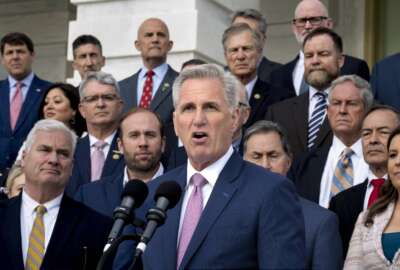
A default isn’t a shutdown, but agencies could treat it that way
That smooshy sound you hear is everyone squirming in their seats as the national-debt default looms closer. The weird thing is, the government is fully appropriated...
That smooshy sound you hear is everyone squirming in their seats as the national-debt default looms closer. The weird thing is, the government is fully appropriated for the rest of fiscal 2023, with four months of high spending yet to go. Contractors worry agencies might treat a default as if it were a shutdown. For more observations, Federal Drive with Tom Temin spoke with federal sales and marketing consultant Larry Allen.
Interview Transcript:
Tom Temin And Larry, you’ve seen evidence that agencies are preparing in the way they would prepare for a shutdown, even in the absence of any guidance we’re aware of from the White House.
Larry Allen Tom, we really have seen that. We’ve seen agencies do their continuity of operations planning, which on one level they have to do, but they’re treating it like a shutdown in that they’re trying to decide who’s essential, who’s nonessential. And as you pointed out, look, everybody’s been appropriated for the year. Now, paying bills is another area, then appropriations. But it’s not like we don’t have an appropriated budget. It’s not like there’s not money that not only can be spent, but there’s a lot of precedent out there in the legal department that says it needs to be spent during the fiscal year. And while there may be some questions about what bills people can pay and where the expenses are going to go, this is not the same thing as a non appropriated funds event. And you really need to have an appreciation for that and provide the right guidance to agencies so they can in turn provide the right guidance to their contractors.
Tom Temin Yeah. And contractors though feel that things could stop, but we really don’t know what it is that would be prioritized. I think it’s the default opinion seems to be coming around that Social Security expenditures or maybe Medicare or something that are the so-called non-discretionary spending would be halted because Congress could use those funds to cover the debt related costs.
Larry Allen Well, Social Security and Medicare and service on the national debt or so-called mandatory spending, and mandatory means just that you have to spend money on them. By the way, those are spending programs that are not really impacted by not having an appropriation. They go on to function just as they always do, and I suspect they would under any type of debt default. Congress would have some serious explaining to do if they decided to change mandatory spending rules at the 11th hour to divert money and pay debt related expenditures rather than send out Social Security checks. More likely, Tom, I think we’re going to find that Congress makes cuts in the non-discretionary money. That is the money that goes to fund government acquisitions, among other things. That’s a smaller portion of federal spending. But nevertheless, it’s the part that is touchable by a downturn, by a potential budget ceiling default money that is in the pipeline or might be paid to contractors. That’s going to be selectively paid depending on the length and severity of any default. So already, Tom, we’re starting to see anecdotal evidence of agencies slowing down their buying habits right at a time of year when you’d expect them to be going up. As you mentioned in the intro, we’re into the third quarter now. The fourth quarter is right around the corner. This is when a lot of government business gets done, and yet there’s some hesitancy in part of the market to move forward with major acquisitions because people don’t know if they’re going to be going home for a while. They don’t want to, on the government side, award a contract if they’re not sure, they’re going to be able to pay for it.
Tom Temin We’re speaking with Larry Allen, president of Allen Federal Business Partners. And, of course, this is all unknowable and we just have to wait and see what our political leadership in their wisdom comes up with. But I wanted to ask you about the IDIQ landscape. You were commenting this week that these just seem to be ever mired in protests, sometimes even before the solicitation and sometimes between solicitation and selection of awardees, let alone once it’s awarded the protests and earlier upstream all the time.
Larry Allen I’m a big advocate of indefinite delivery, indefinite quantity contracting. I’ve spent much of my professional career in this world, whether it’s with the GSA schedules program or another type of governmentwide acquisition contract. I’m generally a big supporter of IDIQ contracting. And yet we do have to address the reality right now. And the reality is that this is a very protest laden way of doing government business, particularly when an agency is trying to put an acquisition together. There are protests at the pre RFP stage. After the RFP is issued, there are protests there that often stop a procurement cold until they can be resolved. And if they can’t be resolved, which was the case recently in one of GSA’s protest cases in Polaris, then they have to go back to the drawing board. And even if you get to the award phase, as NIH is finding out in their CIO-SP4 contract, there are protests that come after awards that push the start of the new program even further to the right. And in the meantime, a whole lot of companies are spending a whole lot of money on bid and proposal dollars. The agency is spending a lot of time and resources putting contracts together and then defending protests at various protest venues. The whole thing is once an IDIQ contract is in place, it’s a nice, fast, efficient way for government agencies to make a number of buys. There’s all kinds of socio economic designations that typically go along with this type of contract. But the road to get to that point is progressively covered in protest potholes.
Tom Temin And the sad thing is the agencies that issue these NIH, GSA principally and NASA, a couple of others, they use these as experimental zones. We have seen many innovations in procurement, such as task order level pricing, which has been suspended by a court decision at the moment. And it makes you wonder why agencies would continue to try to innovate in an area that needs innovation when everything gets mired down this way.
Larry Allen I couldn’t agree more. I think that if I’m GSA particularly, I have to take a really hard look to see whether or not it’s even worth my time and resources to try to come up with another small business I.T. focused IDIQ contract. They’ve tried twice now, Tom, and both times those attempts have been torpedoed by protests. As you mentioned, most recently, GSA is trying to be innovative on Polaris. And somebody took issue with not having contract level pricing. Generally, the vendor community was excited about the prospect of not having contract level pricing for a number of reasons, not the least of which is the contract management burden goes way down if you’re not submitting price information up front to GSA in order to justify contract level pricing before you are eligible for an award. But we didn’t get that on Polaris. Somebody protested and the judge took a very narrow reading of the rule, didn’t like the exceptions that GSA had tried to carve out for itself. Ultimately, you have to look, if I’m GSA, I’m looking at the schedules program. I’m looking at Alliant two with Alliant three coming right down behind it, which is a much larger program that’s going to take my resources. I’ve got 8(a) stars and I’ve got the veterans contract in place, all of which are good I.T. vehicles. And I have to ask myself if I need to spend another two years trying to get an I.T. small business contract up and running, or whether I’m just better off strengthening the programs I’ve got and going with those.
Copyright © 2025 Federal News Network. All rights reserved. This website is not intended for users located within the European Economic Area.
Tom Temin is host of the Federal Drive and has been providing insight on federal technology and management issues for more than 30 years.
Follow @tteminWFED
Related Stories





